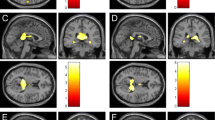Abstract
Chronic fatigue is among the manifestations of focal brain lesions. It is most often encountered in multiple sclerosis (MS) and patients with the sequelae of traumatic, inflammatory, and vascular brain damage (encephalopathies). The aim of the present work was to study the mechanisms of formation of this syndrome in 50 patients with focal brain lesions of different origins (in the inactive stage) and to assess the possibility of correcting it using the combined agent Fezam (2 capsules t.i.d. for one month), which contains piracetam and cinarrizine. In patients with encephalopathies, chronic fatigue syndrome was directly associated with the severity of depression. Patients with MS showed changes in the value-sense sphere. Neuropsychological testing showed that the psychological and personality components played a greater role in the origins of chronic fatigue in patients with encephalopathies than in those with MS. Fezam significantly decreased the severity of chronic fatigue, particularly in patients with MS; in the second group (non-MS patients) this was accompanied by a decrease in the severity of depression. Mild side effects (in six patients — 12%) consisted generally of sleep disturbances. These results indicate that Fezam should be used in the treatment of chronic fatigue in patients with focal brain lesions; in encephalopathies it should be combined with psychoactive agents.
Similar content being viewed by others
References
A. N. Boiko, A. A. Kabanov, T. A. Es’kina, et al., “Efficacy of Fezam in patients with chronic impairments of cerebral circulation,” Zh. Nevrol. Psikhiat., 105, No. 1, 36–41 (2005).
E. I. Gusev and A. N. Boiko, Multiple Sclerosis: from Studies of Immunopathogenesis to New Therapeutic Methods [in Russian], Gubernskaya Meditsina, Moscow (2001).
Multiple Sclerosis and Other Demyelinating Diseases. Handbook for Doctors [in Russian], E. I. Gusev, I. A. Zavalishin, and A. N. Boiko (eds.), Miklosh, Moscow (2004).
A. A. Kabanov, A. N. Boiko, T. A. Es’kina, et al., “Pharmacoeconomic aspects of the treatment of patients with chronic impairments of cerebral circulation with Fezam, piracetam, and cinnarizine,” Trudnyi Patsient, 4, 12–17 (2004).
C. Colosimo, E. Millefiorini, E. Grasso, et al., “Fatigue in multiple sclerosis is associated with specific clinical features,” Acta Neurol. Scand., 92, 353–355 (1995).
L. A. Hershey and W. A. Olszewski, “Ischemic vascular dementia,” in: Handbook of Demented Illnesses, J. C. Morris (ed.), Marcel Dekker Inc., New York (1994), pp. 335–351.
S. Hoyer, “Memory function and brain glucose metabolism,” Pharmacopsychiatry, 36, Suppl. 1, S62–S67 (2003).
L. B. Krupp, P. K. Coyle, C. Doscher, et al., “Fatigue therapy in multiple sclerosis: results of a double-blind, randomized, parallel trial of amantadine, pemoline and placebo,” Neurology, 45, 1956–1961 (1995).
W. I. McDonald, A. Compston, G. Edan, et al., “Recommended diagnostic criteria for multiple sclerosis: guidelines from the International Panel on the diagnosis of multiple sclerosis,” Ann. Neurol., 50, 121–127 (2001).
U. Roeleke, L. Kappos, J. Lechner-Scott, et al., “Reduced glucose metabolism in the frontal cortex and basal ganglia of multiple sclerosis patients with fatigue: an ISF-fluorodeoxyglucose positron emission tomography study,” Neurology, 48, 1566–1571 (1997).
G. L. Sheean, N. M. F. Murray, J. C. Rothwell, et al., “An open-labelled clinical and electrophysiological study of 3, 4-diaminopyridine in treatment of fatigue in multiple sclerosis,” Brain, 121, 967–975 (1998).
C. M. Stork and R. S. Hoffman, “Characterization of 4-aminopyridine in overdose,” J. Tox. Clin. Toxicol., 32, 583–587 (1994).
B. G. Weinshenker, M. Penman, B. Bass, et al., “A double-blind randomized, cross-over trial of pemoline in fatigue associated with multiple sclerosis,” Neurology, 42, 1468–1471 (1992).
M. Zumkeller, H. E. Heissler, and H. Dietz, “On the effect of calcium antagonists on cerebral blood flow in rats. A comparison of nimodipine and flunarizine,” Neurosurg. Rev., 20, 259–268 (1997).
Author information
Authors and Affiliations
Additional information
__________
Translated from Zhurnal Nevrologii i Psikhiatrii imeni S. S. Korsakova, Multiple Sclerosis, Supplement, No. 3, pp. 122–129, 2006.
Rights and permissions
About this article
Cite this article
Boiko, A.N., Batysheva, T.T., Matvievskaya, O.V. et al. Characteristics of the formation of chronic fatigue syndrome and approaches to its treatment in young patients with focal brain damage. Neurosci Behav Physiol 37, 221–228 (2007). https://doi.org/10.1007/s11055-007-0005-8
Issue Date:
DOI: https://doi.org/10.1007/s11055-007-0005-8




